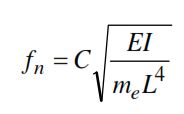Construction of unburied pipeline is the most common method in offshore pipeline system. Unburied pipeline should be designed appropriately due to the bathymetry condition. And it is inevitable founding the existence of free span. Free spanning in offshore pipelines mainly occurs as a consequence of uneven seabed and local scouring due to flow turbulence. An illustration of free span is showed by the figure below:
According to Fredso and Sumer (1997), resonance is the main problem for offshore pipelines laid on the free spanning. Resonance happens when the environment’s frequency becomes equal to the pipe natural frequency. Resonance may lead to develop more fatigue on pipelines. In order to reduce the risk caused by free spanning, a maximum allowable length of free span should be determined. Span length is described with the following image:
An allowable length of free span can be calculated by the following formula (DNV 1998 & ABS 2001) :
in which E = modulus of elasticity; I = bending moment of inertia pipeline; C = coefficient of seabed condition; Vr = reduced velocity (Fredso and Sumer, 1997).
Vr defined as:
where U = streamwise flow velocity; D = outer diameter of pipe; me = effective mass (including structural mass, mass of content and added mass); fn = natural frequency of the pipe free span.
Natural frequency of free span pipe defined as:
In practice, the use of these formula for estimation of maximum free span length is not very applicable since there is difficulties in determining the exact seabed conditions.Therefore, different approaches usually adopted. One of the method is modal analysis.
Modal Analysis
Natural frequency of pipelines can be obtained using the Euler-Bernoulli beam equation which is defined as (Xu et al, 1999 and Bai, 2000):
with y = in-line displacement of pipe; x = position along the pipe span; t = time; C = total damping ratio; T = axial force of pipe (positive under tension); and F(t,u,y) = total external forces.
External forces and damping ratio only influence the resonance amplitude, so it can be ignored and the pipe free vibration equation is expressed in the following equation:
There are several codes that can be used as reference containing free spanning on offshore pipeline, like DnV RP F105 (Pipeline Free Spanning) and API RP 11 11, 1999.
PREVENTION
In order to prevent crack due to free spanning, supports can be made to reduce the stress on the free span area. These supports include sand-filling or mini structure. A mini structure is shown in figure below:
Sumber:








Tidak ada komentar:
Posting Komentar